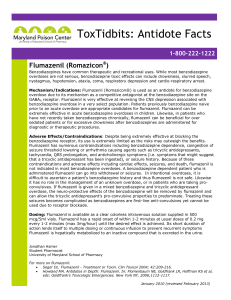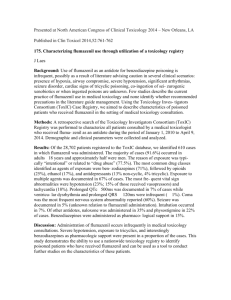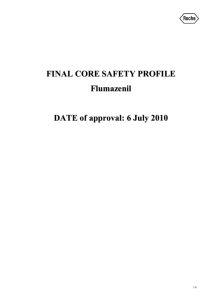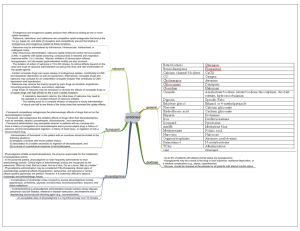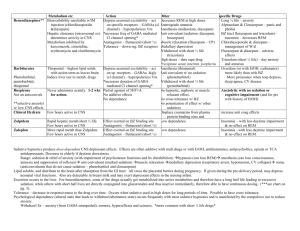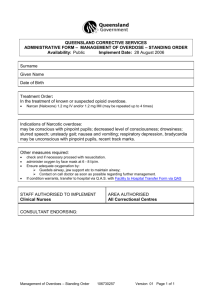efficacy of flumazenil in the management of benzodiazepine overdose
advertisement
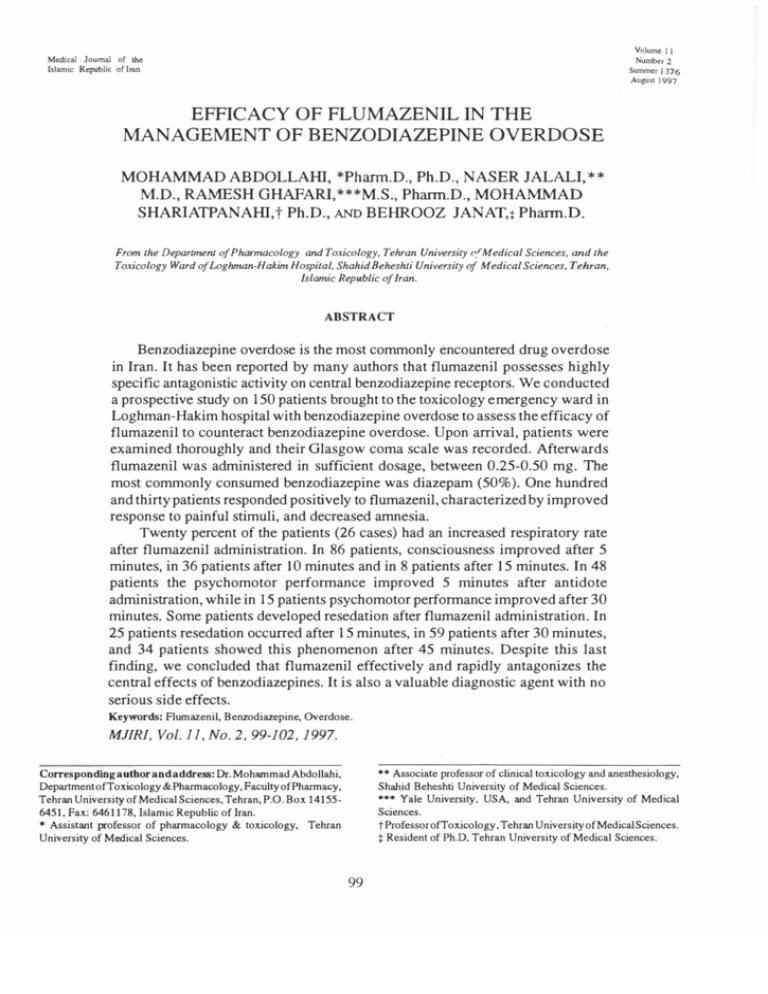
11 2 Summer 1376 August 1997 Volume Medical Journal of the Number Islamic Republic ofIran EFFICACY OF FLUMAZENIL IN THE MANAGEMENT OF BENZODIAZEPINE OVERDOSE MOHAMMAD ABDOLLAHI, *Pharm.D., Ph.D., NASER JALALI, ** M.D., RAMESH GHAFARI, ***M.S., Phann.D., MOHAMMAD SHARIATPANAHI,t Ph.D., AND BEHROOZ JANAT,t Phann.D. From the Department of Pharmacology and Toxicology, Tehran University ofMedical Sciences, and the Toxicology Ward ofLoghman-Hakim Hospital, Shahid Beheshti University of Medical Sciences, Tehran, Islamic Republic of Iran. ABSTRACT Benzodiazepine overdose is the most commonly encountered drug overdose in Iran. It has been reported by many authors that flumazenil possesses highly specific antagonistic activity on central benzodiazepine receptors. We conducted a prospective study on 150 patients brought to the toxicology e mergency ward in Loghman-Hakim hospital with benzodiazepine overdose to assess the efficacy of flumazenil to counteract benzodiazepine overdose. Upon arrival, patients were examined thoroughly and their Glasgow coma scale was recorded. Afterwards flumazenil was administered in sufficient dosage, between 0. 25-0.50 mg. The most commonly consumed benzodiazepine was diazepam (50%). One hundred and thirty patients responded positively to flumazenil, characterized by improved response to painful stimuli, and decreased amnesia. Twenty percent of the patients (26 cases) had an increased respiratory rate after flumazenil administration. In 86 patients, consciousness improved after 5 minutes, in 36 patients after 10 minutes and in 8 patients after 15 minutes. In 48 patients the psychomotor performance improved 5 minutes after antidote administration, while in 15 patients psychomotor performance improved after 30 minutes. Some patients developed resedation after flumazenil administration. In 25 patients resedation occurred after 15 minutes, in 59 patients after 30 minutes, and 34 patients showed this phenomenon after 45 minutes. Despite this last finding, we concluded that flumazenil effectively and rapidly antagonizes the central effects of benzodiazepines. It is also a valuable diagnostic agent with no serious side effects. Keywords: Flumazenil, Benzodiazepine, Overdose. MJIRI, Vol.ll, No.2, 99-102, 1997. Associate professor of clinical toxicology and anesthesiology, Corresponding author and address: Dr. Mohammad Abdollahi, ** Department of Toxicology & Pharmacology, Faculty of Pharmacy, Shahid Beheshti University of Medical Sciences. Tehran University of Medical Sciences, Tehran, P.O. Box 14155- *** 6451, Fax: 6461178, Islamic Republic of Iran. Sciences. * Assistant professor of pharmacology & toxicology, Yale University, USA, and Tehran University of Medical t Professor of Toxicology , Tehran University of Medical Sciences. Tehran t Resident of University of Medical Sciences. 99 PhD, Tehran University of Medical Sciences. Flumazenil in Benzodiazepine Overdose INTRODUCTION Flumazenil (Ro 15-1788) is a 1,4imidazobenzodiazepine with highly specific and competitive antagonistic activity at the central benzodiazepine (BDZ) receptors.17 It attenuates the cognitive, psychomotor, hypnogenetic, respiratory depressive and electroencephalographic (EEG) effects of BDZ agonists.3 It is also reported that flumazenil (FLM) is valuable for the diagnosis of comatose patients with unknown overdose ingestions, unless tricyclic antidepressant ingestion is suspected.4,5,lo,11 BDZs are among the most widely used drugs in the society.6 They are commonly prescribed for a broad spectrum of illnesses including anxiety disorders, stress, insomnia, seizures, muscular spasms and alcohol withdrawal; they are also used in patients undergoing general anesthesia and conscious sedation. Due to their availability, BDZs are frequently the cause of accidental and intentional overdoses.l2 We designed the current analytical and observational study to evaluate FLM as a diagnostic and therapeutic agent. METHODS This study was conducted prospectively and assessed the effect of FLM in reversing BDZ toxicity in overdosed patients brought to Loghman-Hakim Hospital affiliated to the Shahid Beheshti University of Medical Sciences, Tehran, between November 1994 and August 1995. Flumazenil was purchased from Roche, Switzerland. All patients who were comatose, or had known or suspected BDZ overdose were included in this study and FLM administration was evaluated. Upon arrival, patients were examined and their Glasgow coma scale (GCS) scores were calculated. Their GCS score was again calculated at 5 and 15 minute intervals after FLM administration. Due to lack of objective criteria, parameters such as improvement i n consciousness and psychomotor performance, increased response to pain stimuli, decreased level of amnesia and development of resedation were measured subjectively by managing physicians. Other patient data gathered included gender, age, addiction history, type of agent involved in poisoning (except for 6 patients) and time of ingestion. FLM side effects, the performance of gastric lavage and administration of activated charcoal were also recorded. All the procedures followed were in accordance with the ethical standards of the responsible 100 16 14 .. 12 810 C/O g 8 � 6 ::;; 4 2 o ., o 5 15 Minutes after F'lurnazenll administration Fig. 1. Mean GCS score at 0,5 and 15 minutes after flumazenil administration. 100 80 ., i 'J:' ! "0 60 36· . . · . . . . . · · .. 40 i 20 0 5 10 16 Minutes after F'lurn�enll adminlstration Fig. 2. N umber of patients w hose consciousness improVed after flumazenil administration. committee on human experimentation. RESULTS One hundred and fifty-five patients, 84 females and 71 males were included in this study. Their age was between 15 and 84 years, averaging 49 years. There was no addiction history except to cigarettes in six male patients. The agents involved in poisoning are shown in Table I. As shown in this table diazepam was the most widely used agent (89 patients), followed b y clonazepam (15 patients), chlordiazepoxide (11 patients), oxazepam (10 patients) and flurazepam (9 patients). The time elapsed between drug intake and hospital admission varied between 1 and 24 hours, averaging 10 hours. On admission 40 females and 47 male patients were in coma (GCS<9). The rest of the patients (44 females and 24 males) had a GCS�9. FLM was administered with a dose o( either 0.25 or 0.5 mg. In some patients the dose was repeated (Table II). Twenty-five patients (6 females and 19 males) did not M.Abdollahi, Pharm. D., Ph. D., et aL ··48.· ................................ . Table I. Patients intoxicated with benzodiazepines. Agents involved in poisoning Number of patients Diazepam 89 Clonazepam 15 Flurazepam 9 Oxazepam 10 Chlordiazepoxide 20 16 10 6 26 30 11 Diazepam + Imipramine 6 . Diazepam + Amitriptyline 2 Diazepam + Trifluperazine 3 Diazepam + Phenobarbital 4 6 Unknown Minutes after Flumazenll administration Fig. 3. Total Number of patients whose psychomotor performance 155 improved after flumazenil administration. Table II. Flumazenil dosage. 60 50 ...� 60 . ... . .. .. . . .. . . .. . ...... .. . ...... ....... ..... ... . . . . ... . Dose administered (mg) i40- 'il .28 . . Il. "030- . ......, i20 Times post­ ingestion Number of patients 0.25 1 10 0.25 2 108 21 0.25 3 8 � 0.25 4 20 14 c- :z; 0.50 9 10 0 0-16 -30 -46 -60 -76 -90 -106 -120 ..... DISCUSSION . ...166-180 Minutes after FlumazenU administration Fig. 4, FLM can have great diagnostic importance i n comatose patients or i n intoxicated patients who are unable to provide information concerning type and amount of toxic agent consumed.!5,!6,!8 In our study 26 patients did not respond to FLM. This questions their BDZ intoxication, despite their claims. FLM improves consciousness within a short period of time, and gives the clinician an opportunity to communicate with the patient in order to acquire relevant and useful information.4,8,!2 Number of patients who developed resedation after flumazenil administration. respond to FLM administration. 1n the remaining 130 patients who responded to FLM, GCS was recorded 5 and 15 minutes after its administration. Mean GCS levels show significant gradual improvement (Figure 1). All of this latter group showed an improved response to painful stimuli and decreased amnesia. 25 patients also showed increased respiratory rates. The elapsed time between FLM administration and onset of improvement of consciousness and psychomotor performances are depicted in Figures 2 and 3 respectively. 86 patients had improved consciousness 5 minutes after FLM, 36 patients improved after 10 minutes and 8 patients after 15 minutes. Some of the patients who initially responded developed resedation later. The elapsed time between FLM intake and onset of resedation is illustrated in Figure 4. Mental confusion (50 cases), nausea and vomiting (13 cases), agitation (3 cases) and cardiac arrhythmias (2 cases) were the mild adverse reactions encountered in the course of this study. Improvement of consciousness and resumed protective airway reflexes make gastric lavage a safe procedure without risking pulmonary aspiration.!7 Nonetheless it does not replace proper primary care.8 FLM also improves psychomotor performance within a short period of time (5-30 minutes) and also decreases amnesia. Aarseth et al.! administered FLM in 18 patients suspected to be intoxicated by BDZs and reported its significant effect on consciousness; all patients awakened within minutes. They also report no adverse effect except deterioration of clinical condition 1 to 2 hours after FLM was given. Resedation recurred up to 3 hours after FLM administration.! In general, if a patient shows no signs of resedation within 2 hours 10 1 Flumazenil in Benzodiazepine Overdose after the initial dose, serious resedation at a later time is unlikely.14 Although FLM improved the consciousness of patients recovering from BDZ overdose, the need for adequate monitoring during the resedation period must be emphasized. FLM is usually given up to 1 mg as a single dose. The dose may be repeated every 20 minutes, not to exceed 3 mg per hour. The maximum dose used in our study was 0.5 mg. Similar to what Herd and Clarke9 reported, cardiac arrhythmias and agitation were the worst side effects we encountered. Fortunately, these are not common. unknown etiology . Ann Emerg Med 19: 319-321,1990. 5. Burkhart KK, KUlig KW, Rumak BH: The diagnostic utility of flumazenil (a benzodiazepine antagonist) in coma of unknown origin. Vet Hum Toxicol 31: 376, 1989. 6. Coates W, Evans TC,Gehle D: Flumazenil for the reversal of refractory benzodiazepine-induced shock. J Toxicol Clin Toxicol 29: 53 7-542, 1991. 7. Danton AN, Schwam E, Pitman V: Flumazenil: US clinical pharmacology studies. Eur J Anaesthesiol Suppl 2: 81-95,1988. 8. Geller E, Crome P, Schaller MD: Risks and benefits of therapy with flumazenil (Anexate (R)) in mixed drug intoxications. Eur Neurol 31: 241-250,1991. 9. Herd B, Clarke F: Complete heart block after flumazenil. CONCLUSION Hum Exp ToxicollO: 289,1991. 10.Hodgkinson DW, D riscoll P: Diagnostic utility of When confronting a drug-intoxicated comatose patient, the fIrst step is diagnosis, and the second is treatment. Diagnosis includes type, amount and time of drug intake; according to these parameters, treatment should be instituted. Considering the great number of people who use BDZs in the society, and knowing that BDZs cause a decrease in consciousness, it is very important to increase the patient's consciousness in order to gain information concerning the ingested drugs and thus improve the patient's overall condition. FLM effectively and rapidly antagonizes BDZs central effects, and is a great diagnostic agent with no serious adverse reactions. flumazenil in coma with suspected poisoning (Jetter). Br Med J 302: 238,1991. 11. Hojer J, Baehrendtz S: The effects of flumazenil (Ro 151788) in the management of self-induced benzodiazepine poisoning. Acta Med Scand 224: 357-365,1988. 12. Hojer J, Baehrendtz S, Matell G: Diagnostic utility of flumazenil in coma with suspected poisoning; a double­ blind,randomised controlled study. Br Med J 301: 13081311,1990. 13. Lim AG: Death after flumazenil (letter). Br Med J 299: 858-859, 1989. 14. Product information, Mazicon (R), f lumazenil, Roche Laboratories,Nutley,New Jersey,1991. 15. Ritz R, Zuber M, Elsasser S: Use of flumazenil i n intoxicated patients with coma; a double-blind placebo controlled study in ICU. Intens Care Med 16: 242-247, REFERENCES 1990. 16. Skielboe M, Andersen PM, Weber M: Reversal o f 1. Aarseth HP, Bredesen JE, Grynne B: Benzodiazepine­ benzodiazepine intoxication b y flumazenil. Resuscitation receptor antagonist, a clinical double-blind study. Clin 22: 245-252,1991. Toxicol 26: 283-292,1988. 2. 17. Weinbroum A, Halpern P,Geller E: The use of flumazenil Bodenham AR: Death after flumazenil. Br Med J 299 in the management of acute drug poisoning (a review). (5): 457,1989. 3. Intens Care Med 17: 532-538,1991. Brogden RN, Goa-Karen L: Flumazenil, a reappraisal of its 18. Winkler E, Almog S, Krieger-D: Use of flumazenil in the pharmacological properties and therapeutic efficacy as a diagnosis and treatment of patients with coma of unknown benzodiazepine antagonist. Drugs 42: 1061-1089,1991. etiology. Crit Care Med 21: 53 8-542,1993. 4. Burkhart KK, Kulig KW: The diagnostic utility of flumazenil (a benzodiazepine antagonist) in coma of 102
